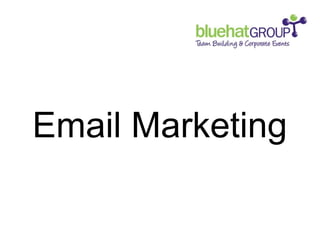Email Marketing Tips & Hints
- 2. Step 1. Ideas brainstorm Type? âąOffer âąProduct promotion âąNewsletter âąCompetition âąNews stories âąWeb page/site launch âąCustomer feedback Format? âąRT (rich text) âąHTML
- 3. Step 2. Data/Segmentation Segmented data allows us to create emails with a bespoke approach. We often split our data and subsequently our emails into three categories: âąClients âąVenues âąAgencies We separate our emails for our brands into different campaigns so that if a contact unsubscribes from brand A, we can still contact them about brand B! Query strings allow us to populate each email with the contacts first and last name as well as the specific Account Managerâs name and email for that contact in the signature. This enables a more personalised approach. We can also populate the email with other contact information fields such as their company, job title and interests.
- 4. Step 3. Design and Copywriting Old school design techniques are best for rendering emails in most clients. This means HTML and tables are the order of the day. Some email clients will read style sheets, but generally itâs best to avoid using CSS and stick to HTML where possible for consistency.
- 5. Step 4. Design Testing Email platforms render HTML emails differently. What looks good in Gmail might look so great in Outlook. Testing your email on all major email clients is therefore paramount to ensuring a consistent layout. We have to test for both desktop and mobile clients too. Test, test, test!
- 6. Step 5. Split testing subject lines Split testing subject lines enables us to better understand what words and phrases our audience respond to. Split testing involves creating 2/3 different subject lines for one email that get sent evenly to 20% of our data list for 30 minutes. The one with the highest open rate is then sent to the remaining 80%. â Brazil World Cup 2014 Competitionâ âWelcome To Brazil, Jamesâ âGet Your Hands on a ÂŁ50 Sportâs Gift Cardâ Winner! âWelcome To Brazil, Jamesâ 30 minutes later
- 7. Step 6. Scheduling Email opens by time of day Email opens by day of week We tend to send our emails from 11:30 â 16:00 between Tuesday and Thursday for maximum exposure. These statistics may vary by industry though, so itâs always worth testing alternative scheduling.
- 9. Step 8. Wait for EnquiriesâŠâŠâŠ
- 13. Industry Standard Open & click rates
- 14. Step 10. Clicks to sales This metric allows us to see who clicked on specific links within an email. If an email has a number of links to our products we separate this data out and then distribute it to the sales team to follow up.
- 15. Step 11. Ring, ring ââI see youâre interested in Mexican Railway!........ââ
- 16. Further Reading http://www.emailmonday.com/mobile-email-usage-statistics https://econsultancy.com/blog/62688-six-case-studies-and-infographics- on-the-optimal-time-to-send-emails#i.1847n7z2kieelx https://www.emailonacid.com/blog/details/C4/engagement_email_ marketing_the_path_between_an_open_and_click
















